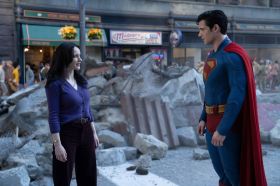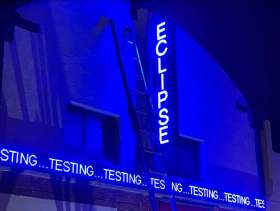The new Australian film Time Addicts follows two best friends, Denise and Johnny, who are both in the throes of drug addiction. As they embark on a perilous journey to settle their debts with a volatile dealer, they must steal a mysterious bag of crystal, the effects of which will transport them through time.
We spoke to its New Zealand writer/director Sam Odlum.
Hi Sam. Where did the idea for Time Addicts come from?
The first real inspiration was Phillip K. Dick’s novel A Scanner Darkly. The story is mind-bending, hilarious and heartbreaking all at once. I always really loved stories that could blend genres in this way, so the film was really an experiment in genre.
I made a short-film version of Time Addicts a few years prior and so that gave me a platform to figure out what the story was for the feature. When it all clicked for me was when I figured out that it needed to be a contained heist movie that takes place in one house through different periods of time.
How do you approach a comedy about drug addiction without being insensitive?
We had a lot of discussions about this early on in development. It was really important for us to not punch down with any of the comedy. If we do laugh at the characters in the film it has more to do with their personalities than their addictions.
Me and the actors spoke at length about giving the characters full authentic lives and not defining them by their addiction alone. In Johnny and Denise’s cases, their addictions are symptomatic of larger issues, so even though they are comedic at times, hopefully they remain authentic and never spill over into parody. Like life, we aimed to make the dark comedy ingrained in the more painful stages of their growth.
What were your main influences for the look and feel of the film?
I’m really influenced by a lot of the modern Korean classics. So when it came to how we moved the camera and the lensing of the film, Memories of Murder and Oldboy were right up there as influences.
I had a lot of discussions with our DOP Marcus Cropp and Production Designer Bianca Milani about the colour of the different time periods of the film and how we could still make them all feel naturalistic in their own way. We were big fans of the way the Netflix series Dark was able to achieve that.
Obviously, the sound design and the music play a huge part in the look and feel of the film too. Our Sound Designer Ryan Granger had to balance the sounds of the different time periods and still make the future feel a part of this world.
Some influences here were Blade Runner and Dune, which sounds ridiculous given the small scale and scope of this film compared to those, but I think him and the sound team did an amazing job with bringing those elements in where needed.
My first conversations with composer James Orr were about Clint Mansell and Cliff Martinez and how we wanted to use that melancholic synth sound to slowly build into the bigger themes in the story. It was important for us that the music steered towards the dramatic and never underscored any of the comedy.
Freya Tingley and Charles Grounds are hilarious together – how did you decide they were right for the roles of Denise and Johnny?
We took a long time to find Johnny because we knew we needed to get that character right for the film to work. We got so lucky eventually finding Charles who has all the elements we were looking for in Johnny – he’s charming, hilarious, and unpredictable.
That meant we only had a couple of weeks to find Denise, which was stressful because she’s at the centre of most of the film.
We had a great feeling about Freya as soon as we saw her but I think what really made her stand out was her understanding of the relationship between the two of them. She never buys in to any of Johnny’s many narratives he has going on inside his own head at any one time. She has her own issues that she’s dealing with and doesn’t have the patience for Johnny.
Luckily, the two of them clicked straight away and developed this hilarious love/hate brother/sister relationship where they intrinsically understand each other but are also somehow never on the same page.
Movies employ many different techniques to convey time travel – how did you approach and achieve this on the production of Time Addicts?
Practically, the time travelling effect was a combination of in-camera effects and VFX. We wanted to do as much in camera as possible to make it feel tangible and just use the VFX sparingly so that when characters disappear or reappear it feels a part of the world.
Conceptually, we do lean on a lot of time travelling tropes but try to put our spin on them so hopefully audiences feel like our approach is unique.
The film showed recently at Monsterfest in Melbourne – how was the reaction?
The reaction was amazing! A lot of laughs, which I think surprised us a bit because we had a lot of discussions in pre-production that while filming we were going to treat the film as a drama – so, I think we kind of forgot that it has a lot of funny moments too.
It’s been great that the comedy is landing, but for me the fact that people are picking up on the emotional components of the story is the most important thing. That’s the hardest part to craft and probably the aspect of the narrative that we worked the hardest on so it’s really cool to see that coming to the foreground.
Time Addicts is in Australian cinemas from 7 December.





